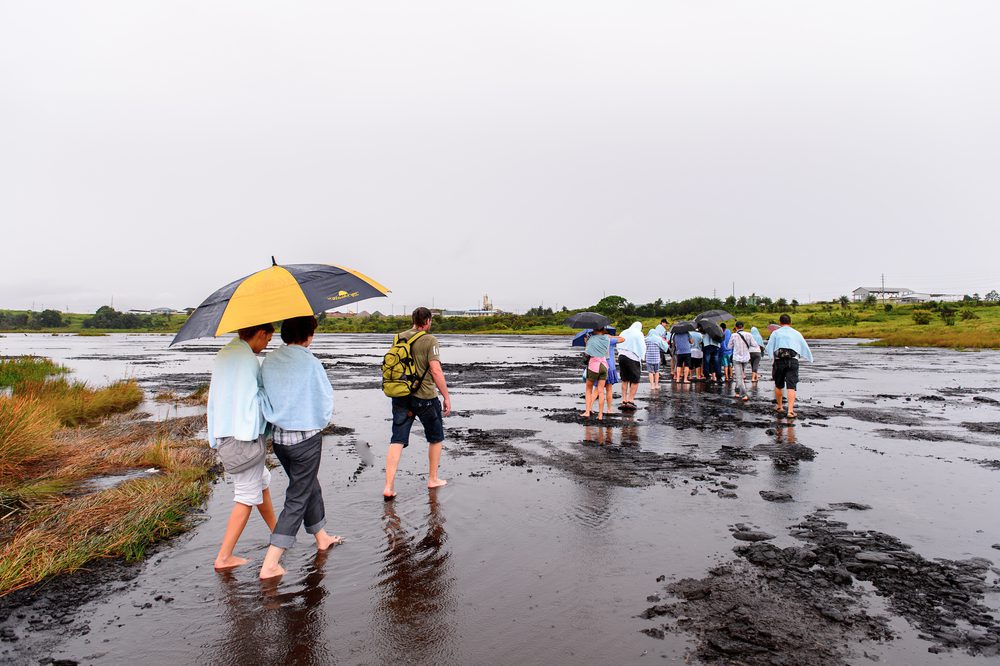Trinidad and Tobago in the Caribbean is home to one of the world’s weirdest lakes. Not only is Pitch Lake brimming with bizarre microbial life, but its “waters” are also such an odd consistency that you can walk across it.
Found near La Brea on the southwestern tip of Trinidad, Pitch Lake is around 40 hectares (100 acres) in size and 76 meters (250 feet) deep. It is chocked full of some 10 million tons of asphalt, aka pitch, which makes it the largest natural deposit of asphalt in the world.
It’s located above the intersection of two of Earth’s geological fault lines. The asphalt is thought to have emerged many thousands of years ago when the fault lines beneath split deep enough to tap into oil and gas reservoirs, causing this highly viscous form of petroleum to spring to the surface.
The abundance of gloopy asphalt gives the lake a very peculiar quality. It essentially acts like a massive field of sludgy asphalt that’s dotted with pools of water. In some places, the lake is sturdy enough to stand on and wander across without too much trouble. In other patches, people who make a wrong step will slowly sink like a spoon falling through thick custard.

Dip stickin’ at Pitch Lake. Image credit: maloff/Shutterstock.com
Owing to the flammable qualities of petroleum, smoking isn’t recommended. It’s said that if you drop a match in any of the water pools then a violent burst of flames will arise.
Despite the unique qualities of this lake (if you can call it that) it hasn’t been investigated by that many scientific studies. However, researchers have looked into the microbial life of the lake and, unsurprisingly, it holds some surprises.
A 2011 study concluded that the “microbial diversity at Pitch Lake was found to be unique when compared to microbial communities analyzed at other hydrocarbon-rich environments.” Along with discovering a bunch of never-before-seen species, the microbial communities that live here were found to be diverse, composed of “deeply branching lineages” of co-existing bacteria and archaea.
The lake is briefly mentioned in the accounts of Sir Walter Raleigh’s expedition to the Caribbean and South America in 1595. Realizing the quality of the asphalt, he used it as a sealant on his leaking ships. He reportedly described the asphalt as “most excellent… It melteth not with the sun as the pitch of Norway”.

Walking on water? Pitch Lake is a major tourist magnet. Image credit: Anton_Ivanov/Shutterstock.com
As the influence of colonialism grew in the Caribbean, European powers exploited this valuable natural resource and shipped the high-quality asphalt all over the world. By the 19th and 20th centuries, commercial asphalt harvesting by the British was well underway and hundreds of thousands of tons were exported globally.
While the English explorer Sir Walter Raleigh is often credited in history books for discovering the lake, it had a long history before European colonialism, as proven by archaeological evidence at the site that dates back to 500 BCE. According to the legends of local Indigenous communities, the lake was created by the Great Spirit as a punishment for the killing of hummingbirds, which were sacred to them.
Today, the lake is still used to extract asphalt, but operations are now controlled by the state-owned company Lake Asphalt of Trinidad and Tobago. The strange sight is also a major magnet for tourists who can join locals to embark on expeditions across the semi-solid lake. At their own risk, of course.
Source Link: The Caribbean's Pitch Lake Is So Sticky You Can Walk Across It